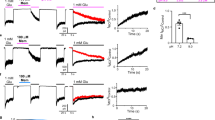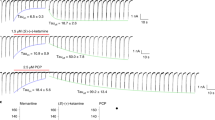Abstract
Since the mid 1980s, there has been a great deal of enthusiasm within both academia and industry about the therapeutic potential of drugs targeting the NMDA subtype of glutamate receptors. That early promise is just beginning to translate into approvable drugs. Here we review the reasons for this slow progress and critically assess the future prospects for drugs that act on NMDA receptor pathways, including potential treatments for some major disorders such as stroke and Alzheimer's disease, for which effective therapies are still lacking.
This is a preview of subscription content, access via your institution
Access options
Subscribe to this journal
Receive 12 print issues and online access
$209.00 per year
only $17.42 per issue
Buy this article
- Purchase on Springer Link
- Instant access to full article PDF
Prices may be subject to local taxes which are calculated during checkout


Similar content being viewed by others
References
Watkins, J.C. in The NMDA Receptor (eds. Collingridge, G. L. & Watkins, J. C.) 1–30 (Oxford Univ. Press, New York, 1994).
McBain, C.J. & Mayer, M.L. N-methyl-D-aspartic acid receptor structure and function. Physiol. Rev. 74, 723–760 (1994).
Das, S. et al. Increased NMDA current and spine density in mice lacking the NMDA receptor subunit NR3A. Nature 393, 377–381 (1998).
Chatterton, J.E. et al. Excitatory glycine receptors containing the NR3 family of NMDA receptor subunits. Nature 415, 793–798 (2002).
Kemp, J.A. & Kew, J.N.C. in Drugs And The Pharmaceutical Sciences Vol. 89 (ed. Leff, P.) 297–321 (Marcel Dekker, New York, 1998).
Williams, K. Ifenprodil discriminates subtypes of the N-methyl-D-aspartate receptor: selectivity and mechanisms at recombinant heteromeric receptors. Mol. Pharmacol. 44, 851–859 (1993).
Kemp, J.A., Kew, J.N.C. & Gill, R. Handbook of Experimental Pharmacology Vol. 141 (eds. Jonas, P. & Monyer, H.) 495–527 (Springer, Berlin, 1999).
Lees, K.R. et al. Glycine antagonist (gavestinel) in neuroprotection (GAIN International) in patients with acute stroke: a randomised controlled trial. GAIN International Investigators. Lancet 355, 1949–1954 (2000).
Sacco, R.L. et al. Glycine antagonist in neuroprotection for patients with acute stroke: GAIN Americas: a randomized controlled trial. JAMA 285, 1719–1728 (2001)
Gotti, B. et al. Ifenprodil and SL 82.0715 as cerebral anti-ischemic agents. I. Evidence for efficacy in models of focal cerebral ischemia. J. Pharmacol. Exp. Ther. 247, 1211–1221 (1988).
Kew, J.N.C., Trube, G. & Kemp, J.A. A novel mechanism of activity-dependent NMDA receptor antagonism describes the effect of ifenprodil in rat cultured cortical neurones. J. Physiol. (Lond.) 497, 761–772 (1996).
Gill, R. et al. Pharmacological characterization of Ro63-1908 (1-[2-(4-hydroxy-phenoxy)-ethyl]-4-(4-methyl-benzyl)-piperidin-4-01), a novel sinotype-selective N-methyl-D-aspartate antagonist. J. Pharmacol. Exp. Ther. 302, 940–948 (2002)
Schwarcz, R.J. Glutamate 2000: old dog, new tricks. Pharmacol. Exp. Ther. 296, 659–662 (2001).
Parsons, C.G. NMDA receptors as targets for drug action in neuropathic pain. Eur. J. Pharmacol. 429, 71–78 (2001).
Boyce, S. et al. Selective NMDA NR2B antagonists induce antinociception without motor dysfunction: correlation with restricted localisation of NR2B subunit in dorsal horn. Neuropharmacology 38, 611–623 (1999).
Chizh, B.A., Headley, P.M. & Tzschentke, T.M. NMDA receptor antagonists as analgesics: focus on the NR2B subtype. Trends Pharmacol. Sci. 22, 636–642 (2001).
Tranquillini, M.E. & Reggiani, A. Glycine-site antagonists and stroke. Expert Opin. Investig. Drugs 8, 1837–1848 (1999).
Leeson, P.D. & Iversen, L.L. The glycine site on the NMDA receptor: structure-activity relationships and therapeutic potential. J. Med. Chem. 37, 4053–4067 (1994).
Chase, T.N., Oh, J.D. & Konitsiotis, S. Antiparkinsonian and antidyskinetic activity of drugs targeting central glutamatergic mechanisms. J. Neurol. 247 (Suppl. 2), 36–42 (2000).
Del Dotto, P. et al. Intravenous amantadine improves levadopa-induced dyskinesias: an acute double-blind placebo-controlled study. Mov. Disord. 16, 515–520 (2001)
Lederer, R., Radeke, E. & Mondadori, C. Facilitation of social learning by treatment with an NMDA receptor antagonist. Behav. Neural Biol. 60, 220–224 (1993).
Mondadori, C., Weiskrantz, L., Buerki, H., Petschke, F. & Fagg, G.E. NMDA receptor antagonists can enhance or impair learning performance in animals. Exp. Brain Res. 75, 449–456 (1989).
Davis, M. The rde of NMDA receptors and MAP kinase in the amygdala in extinction of fear: clinical implications for exposure therapy. Eur. J. Neurosci 16, 395–398 (2002).
Krystal, J.H. et al. NMDA agonists and antagonists as probes of glutamatergic dysfunction and pharmacotherapies in neuropsychiatric disorders. Harv. Rev. Psychiatry 7, 125–143 (1999).
Tsai, G. & Coyle, J.T. Glutamatergic mechanisms in schizophrenia. Annu. Rev. Pharmacol. Toxicol. 42, 165–179 (2002).
Tamminga, C. Schizophrenia and glutamatergic transmission. Crit. Rev. Neurobiol. 12, 21–36 (1998).
Heresco-Levy, U. et al. Placebo-controlled trial of D-cycloserine added to conventional neuroleptics, olanzapine or risperidone in schizophrenia. Am J. Psychiatry 159, 480–482 (2002).
Tsai, G., Yang, P., Chung, L.C., Lange, N. & Coyle, J.T. D-serine added to antipsychotics for the treatment of schizophrenia. Biol. Psychiatry 44, 1081–1089 (1998).
Mothet, J.P. et al. D-serine is an endogenous ligand for the glycine site of the N-methyl-D-aspartate receptor. Proc. Natl. Acad. Sci. USA 97, 4926–4931 (2000).
Wolosker, H., Blackshaw, S. & Snyder, S.H. Serine racemase: a glial enzyme synthesizing D-serine to regulate glutamate-N-methyl-D-aspartate neurotransmission. Proc. Natl. Acad. Sci. USA 96, 13409–13414 (1999).
Tang, Y.P. et al. Genetic enhancement of learning and memory in mice. Nature 401, 63–69 (1999).
Malayev, A., Gibbs, T.T. & Farb, D.H. Inhibition of the NMDA response by pregnenolone sulphate reveals subtype selective modulation of NMDA receptors by sulphated steroids. Br. J. Pharmacol. 135, 901–909 (2002).
Husi, H., Ward, M.A., Choudhary, J.S., Blackstock, W.P. & Grant, S.G. Proteomic analysis of NMDA receptor-adhesion protein signaling complexes. Nat. Neurosci. 3, 661–669 (2000).
Sheng, M. The postsynaptic NMDA-receptor–PSD-95 signaling complex in excitatory synapses of the brain. J. Cell. Sci. 114, 1251 (2001).
Hardingham, G.E., Fukunaga, Y. & Bading, H. Extrasynaptic NMDARs oppose synaptic NMDARs by triggering CREB shut-off and cell death pathways. Nat. Neurosci. 5, 405–414 (2002).
Lu, W. et al. Activation of synaptic NMDA receptors induces membrane insertion of new AMPA receptors and LTP in cultured hippocampal neurons. Neuron 29, 243–254 (2001).
Perin-Dureau, F., Rachline, J., Neyton, J. & Paoletti, P. Mapping the binding site of the neuroprotectant ifenprodil on NMDA receptors. J. Neurosci. 15, 5955–5965 (2002).
Author information
Authors and Affiliations
Corresponding author
Rights and permissions
About this article
Cite this article
Kemp, J., McKernan, R. NMDA receptor pathways as drug targets. Nat Neurosci 5 (Suppl 11), 1039–1042 (2002). https://doi.org/10.1038/nn936
Received:
Accepted:
Published:
Issue Date:
DOI: https://doi.org/10.1038/nn936
This article is cited by
-
Potential therapeutic strategies for photoreceptor degeneration: the path to restore vision
Journal of Translational Medicine (2022)
-
Targeting NMDA receptors in neuropsychiatric disorders by drug screening on human neurons derived from pluripotent stem cells
Translational Psychiatry (2022)
-
Fentanyl-induced hyperalgesia and analgesic tolerance in male rats: common underlying mechanisms and prevention by a polyamine deficient diet
Neuropsychopharmacology (2022)
-
Memantine in neurological disorders – schizophrenia and depression
Journal of Molecular Medicine (2021)
-
Synthesis and preliminary evaluation of novel 11C-labeled GluN2B-selective NMDA receptor negative allosteric modulators
Acta Pharmacologica Sinica (2021)



